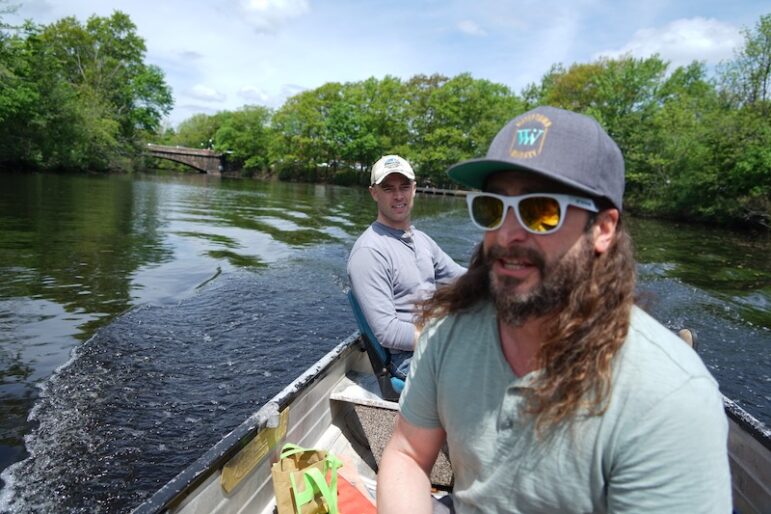
On a sunny spring day, the two men behind the effort to create a water shuttle from Watertown to Boston hopped on a small motor boat to give Watertown News a preview of what a trip down the Charles River would be like.
Drew Rollert, who came up with the idea after being stuck in traffic trying to get to Fenway Park from Watertown as the waters of the Charles River remained quiet, hopes to start a pilot shuttle by the fall of 2024. The company, called Wada Hoppah, has applied for a grant to get the electric-powered shuttle sailing.
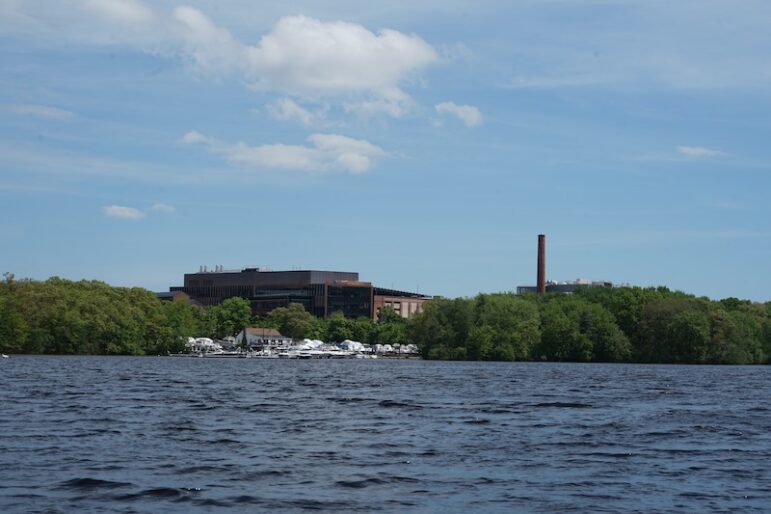
The voyage from the dock in Watertown Square takes passengers from the natural beauty of the Charles in Watertown, past major universities, along the historic Back Bay, and into the industrial area near the Charles River Locks. Along the way, Rollert pointed out spots where he hopes his boats will be picking up and dropping off passengers, including some that were built to do so more than a century ago.
“Charles Eliot wanted *electric* water ferries in 1894,” the Wada Hoppah website said, quoting from the Mass. Department of Conservation and Recreation’s 2002 Master Plan. Rollert said some of the gateways to the river designed by Eliot can be identified by the architecture, including in Watertown Square. The wide granite steps leading down from an entrance lined with small columns can be seen by the dock, as well as along the Esplanade and near Beacon Hill.
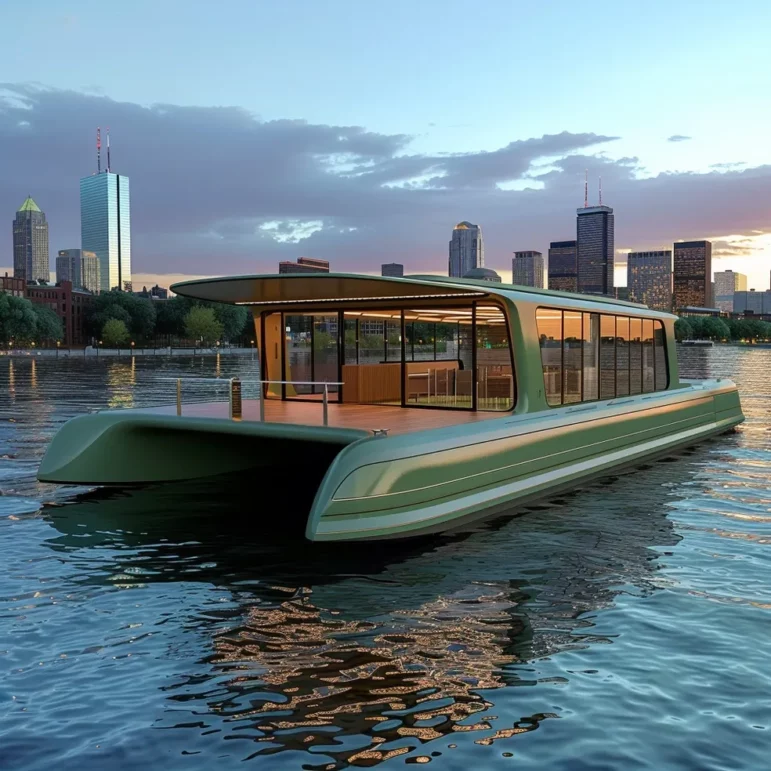
A boat has been designed to navigate the waters of the Charles, which can get just a couple feet deep in sections in Watertown, and would carry up to 40 passengers. Rollert would like to start from the dock in Watertown Square, have stops near Arsenal Yards, along the Esplanade, one by the Hatch Shell, another serving Kendall Square in Cambridge, and ending near the TD Bank Garden.
He envisions the shuttle serving commuters, as well as people looking to get to Red Sox, Celtics and Bruins games. Also to bring people into Watertown from Boston to eat at restaurants and shops in Watertown Square and at Arsenal Yards.
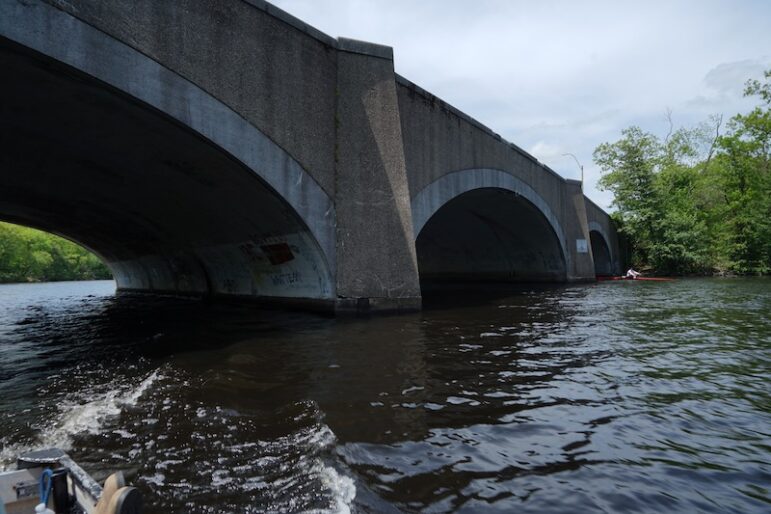
The latest design of the Wada Hoppah boat nearly doubles the seating capacity of the first version. If Wada Hoppah can start running this year, it would be one of the first, if not the first, electric water shuttles in the United States. Rollert hopes to get some funding assistance.
On May 31, an application was submitted for a clean transportation pilot grant for the Charles River water shuttle, along with letters of support from the City of Watertown, State Reps. Steve Owens and John Lawn, Boylston Properties (owners of Arsenal Yards), Davis Group, and The Speedway in Brighton.
“If we get it, it would allow us to have a green transportation pilot running as soon as August/September while we build our own fleet,” Rollert said. “And it would allow Watertown’s lower income residents to have free, clean transportation to and from Boston.”
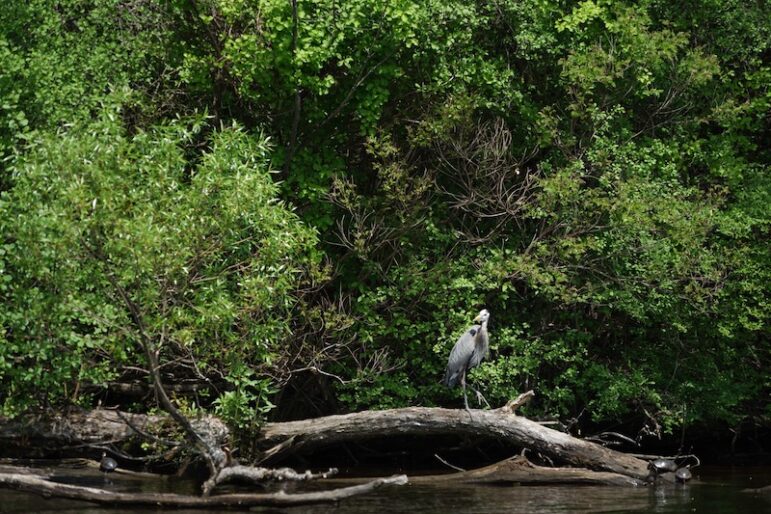
The City is named as a co-applicant, but it will not have a financial obligation, Rollert said.
“I want to thank Watertown, and specifically (City Manager) George Proakis, (Senior Transportation Planner) Zeke Mermell, and (Director of Planning and Zoning) Gideon Schreiber for their guiding advice – furthering our efforts to be on the forefront of clean marine transportation in the U.S.,” Rollert said.
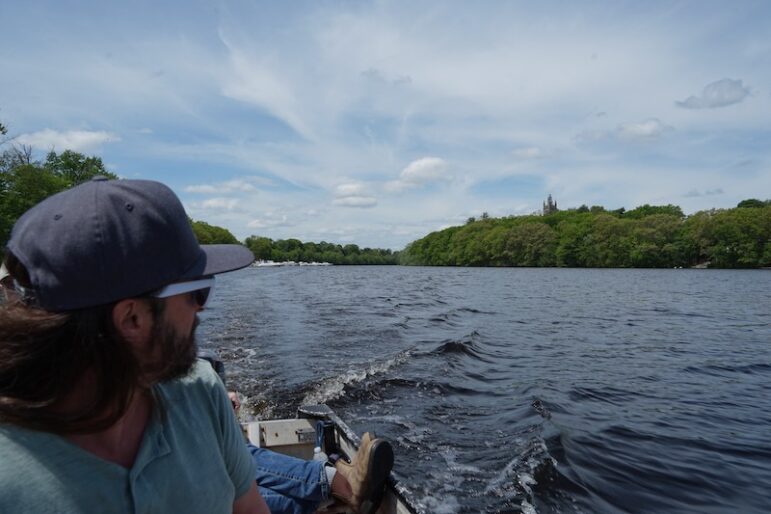
Boylston Property’s retail, office, and residential development could benefit from the shuttle, said Andrew Copelotti, a principal with Boylston Properties.
“We’re supportive of any alternative mode of transportation to bring people to Arsenal Yards,” Copelotti said.
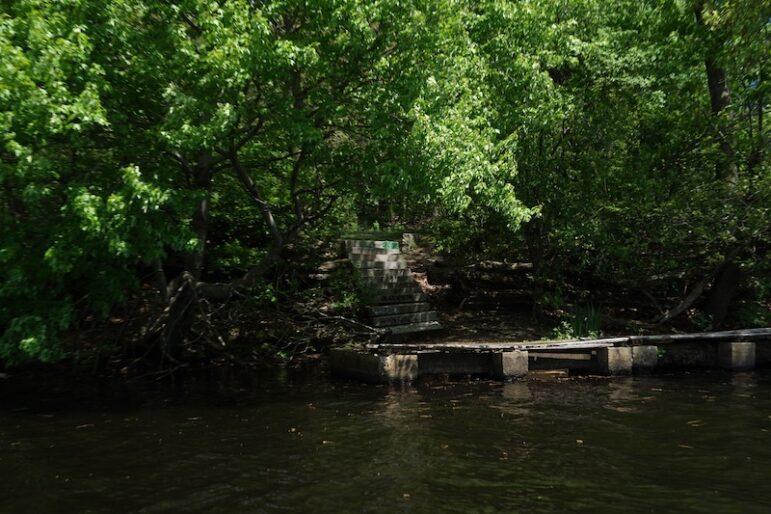
Copelotti added that a path was built from the parking lot near 100 Forge, the tallest building at Arsenal Yards, down to Greenough Boulevard and the Charles River, where an old dock is located.
Rollert said that dock has seen better days, and would need to be rebuilt, but it just takes a few minutes walking to get to the restaurants in Arsenal Yards from the dock.
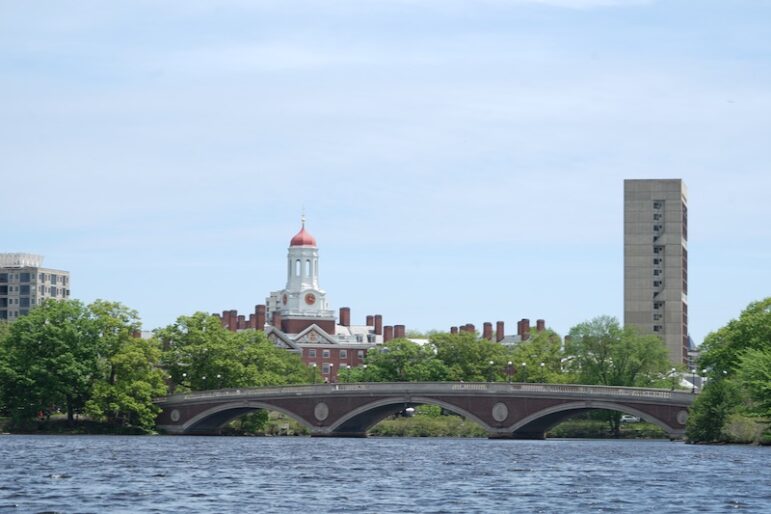
The trip will take about an hour from Watertown to the far end of Boston, Rollert said.
Rollert teamed with Will Congram, who will captain the Wada Hoppah. Congram, a Watertown resident who grew up on the river, knows the rules of the water as well as the oddities of the river, such as the shallow part of the river near the Newton Yacht Club.
“One of my first memories is being handed into my Dad’s arms in a boat,” Congram said, referring to his father Walter “Buzz” Congram, who coached the Northeastern crew team for 23 years. Will rowed for the Huskies and coached at Community Rowing.
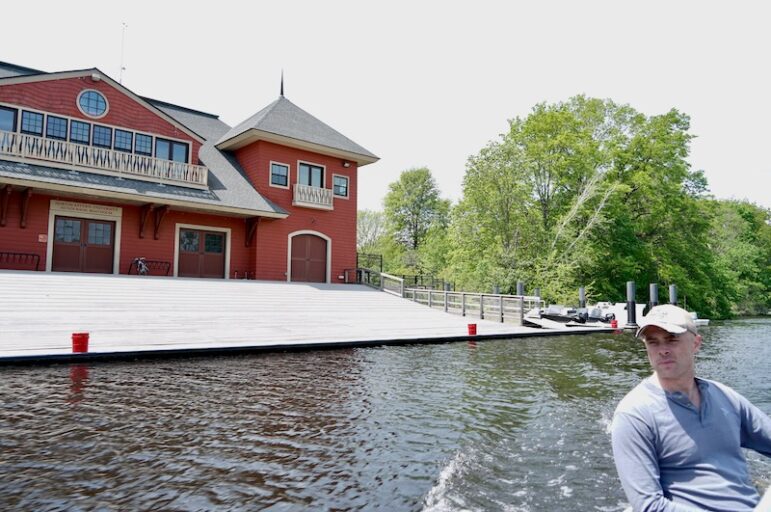
A trip from Watertown to Boston does not just involve turning on throttle and heading straight for the Hub. The boat must slow near the various docks along the way to prevent damage caused by boat wakes, and then in more open areas the boat can speed up. The boat has been designed to reduce the wake so that it does not damage docks at rowing boathouses and yacht clubs along the route.
The Charles River is mostly devoid of boat traffic from Watertown Square past the Newton Yacht Club on the right, and the Watertown Yacht Club a bit east on the left. The tall lab building at Arsenal Yards, 100 Forge, can be seen above the trees looking in one direction, and the tower at Perkins School for the Blind is visible looking in the other direction.
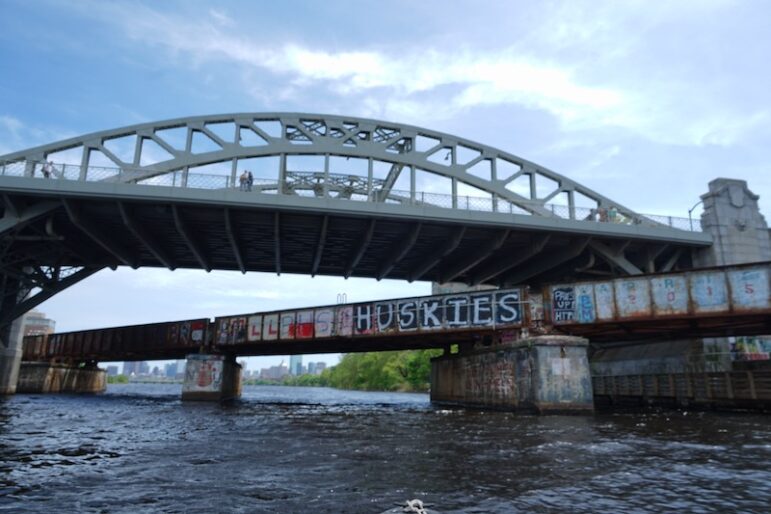
The Newton Yacht Club will play a key role in the Wada Hoppah plan. They agreed to allow an electric charger to be installed to charge up the boats, Rollert said.
A few rowers and kayakers begin to appear as you go past the first boat house (Community Rowing) and the kayak/canoe rental spot in Herter Park in Brighton. A few more can be seen from the JFK Bridge to the BU Bridge, and then the river comes to life as the river widens near the Back Bay: sail boats, pleasure boats, Duck Boats, rowers, and even a guy on a personal hydrofoil zipping around.
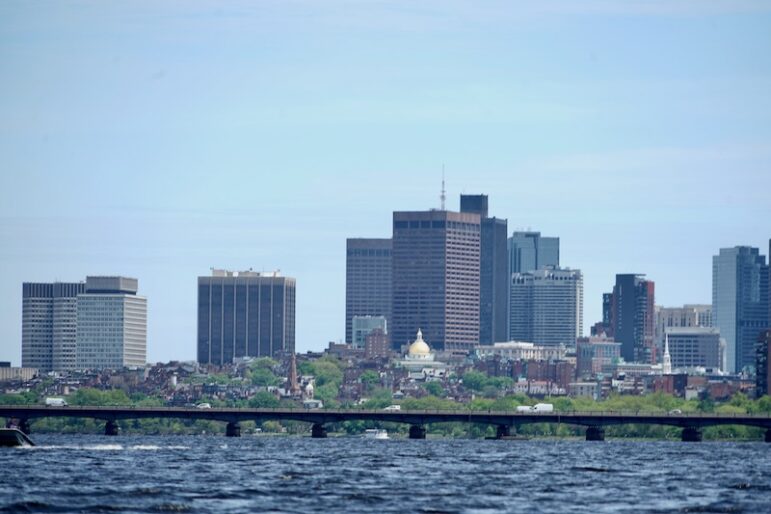
Rollert pointed out a dock along the Esplanade that was being used by several sunbathers, but no boats. He hopes to make that a stop. Another dock sits less than 100 feet from the Hatch Shell.
The boat traffic decreases again after passing under the Longfellow Bridge, with only Duck Boats chugging along. The river narrows to a thin channel near the Museum of Science. Our boat passed within quacking distance from a Duck Boat heading the other direction. The channel opens up again as the Zakim Bridge looms above.
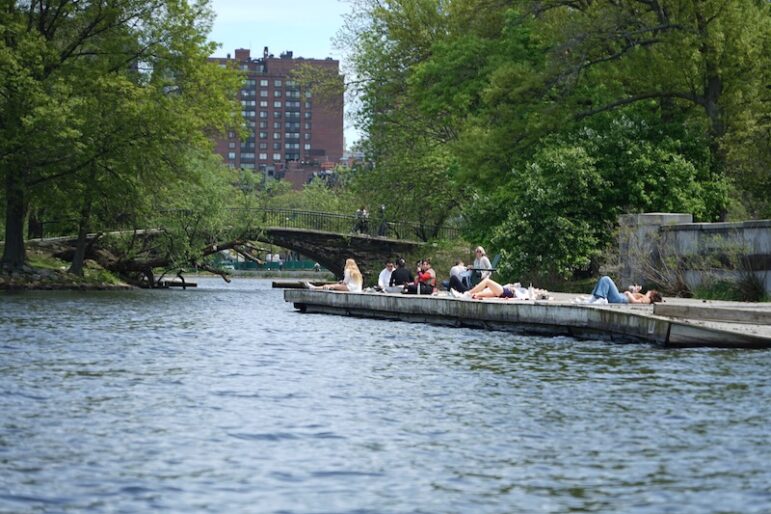
Before getting to the bridge, a newish looking dock sits quietly at the foot of a Mass. General Hospital building.
“I asked someone who works there who uses the dock and they said they had never seen anyone use it,” Rollert said.
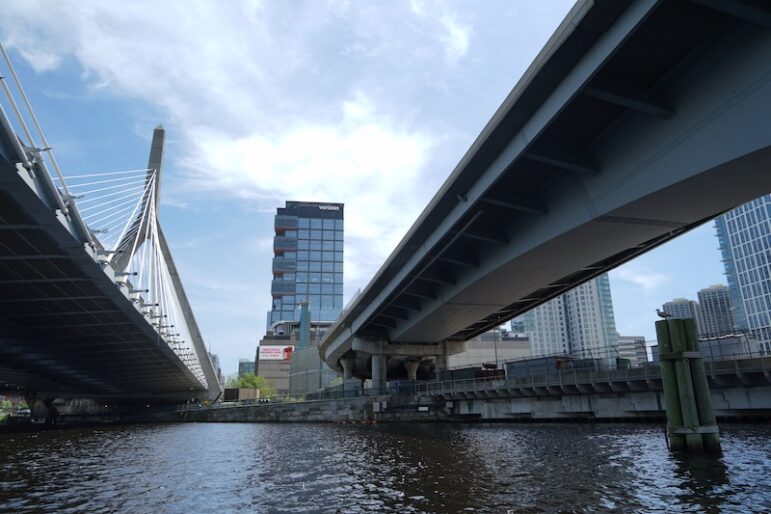
Passing under the bridge, the boat emerged east of the TD Garden, and ran into the locks in the Charles River Dam. At that point Congram swung the boat around and headed west toward Watertown.
He found an inlet he had never explored that has openings on both sides of North Point Park in Cambridge.
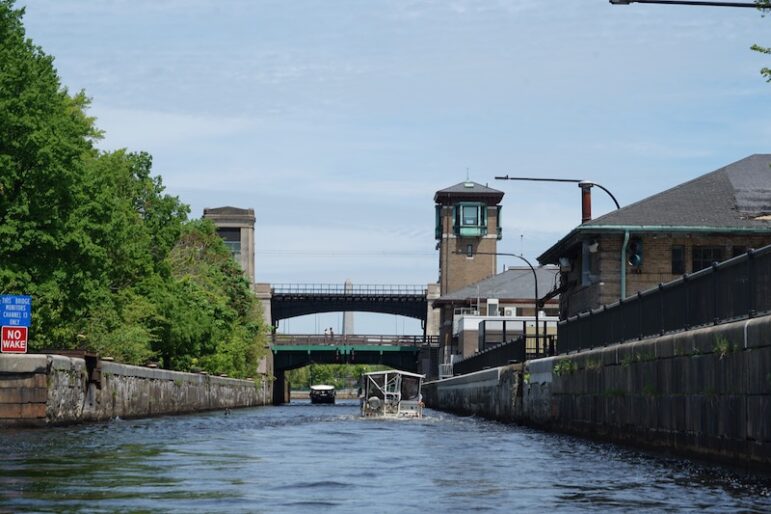
The trip back includes a close look at Gerry’s Landing, the spot where the colonists, led by Richard Saltonstall, landed in 1630 in what would become Watertown. The area, near the Eliot Bridge, is now part of Cambridge. You can also get a good view of the island in the river near the Watertown Yacht Club.
There are several more bends in the river before the final destination comes into view. On the day of our trip, a handful of fishermen used the dock, but no other boats were spotted.
“This is the way to arrive in Watertown Square,” Rollert said.
(Members of Watertown News’ Patreon page can see more photos from the trip down the Charles River by clicking here).
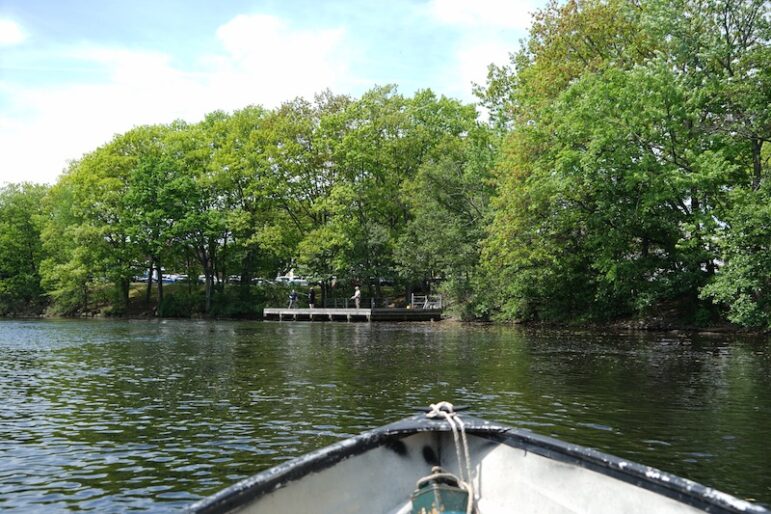
Best of luck! I can’t wait to take a ride.
Absolutely the best idea since sliced bread!
Reminder to sign comments with your full name.
Reminder to sign comments with your full name.
What a great idea. Would love to get into Boston that way.
Cant wait!
What a wonderful concept, both environmentally and commercially. Avoid the traffic, noxious auto fumes, and parking woes! I can imagine dining in Boston with only beauty and fresh air on my journey to and fro. Thank you!!!!!
Fabulous idea! What a relaxed way to get to Boston and enjoy what the river has to offer. Can’t wait to try it.
Drew & Will – Very exciting. Besides making so much sense, you are taking such care to be respectful of history, the river, nature, and more. Beautiful design (& color) for your electric shuttle. Thank you for all your work to make this happen!
With the goal to diminish cars, it would bring this service full circle by having lockable, secure bike lockers or cages – as they do in Amsterdam, etc. Maybe that’s already in your plans. Even better if you could find some manufacturers of these products who would like to support this “first” which I’m sure is going to get so much press. Or for Arsenal Yards and the apartment buildings to fund some for that stop….
And Charlie Breitrose – what a great article and images. Thank you.J